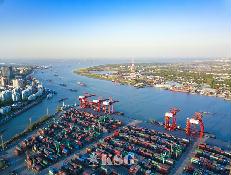2020-08-18 08:57
Vietnam-Dynamic Trading Partner for the Port of Hamburg

The EU-Vietnam Free Trade Agreement has entered into force on August 1 2020. Trade between the Port of Hamburg and Vietnam, which has already increased in recent years, should continue to benefit from this agreement.
Although the corona-related developments will also affect trade between Germany and Vietnam in the current year 2020, for the Port of Hamburg there has been very positive growth in the Vietnam shipping region in the recent past.
In 2019, a new record quantity of 106,000 standard containers (TEU) was moved between Hamburg and Vietnam. This increase of 15 percent compared to the previous year is also due to direct connections which are now offered by the carriers for this route.
The free trade agreement between the EU and Vietnam, which was ratified by the European Parliament and the Vietnamese National Assembly in the first half of 2020, promises to create new market incentives that result in increased transport volumes between those markets.
Customs barriers are to be dismantled for this. This applies in particular to deliveries of goods from Europe, for which 99 percent of all customs duties are to be reduced within ten years. The EU, in turn, will reduce tariffs to 84 percent of Vietnamese products to 0 percent when the free trade agreement comes into force. After seven years, this is to be the case for 99 percent of the tariffs.
Vietnam is part of a large number of free trade agreements and, among other things, is trying to position itself as an attractive production location in Southeast Asia. This applies in particular to companies that are relocating their production within Asia due to increased costs. Vietnam plans to invest USD 3.8 billion in the country's port infrastructure in order to manage the resulting flow of goods.
Five scheduled services connect the Port of Hamburg with Vietnam, with ports in both the north and south of the country being approached. In addition to two container services, three multi-purpose services are operated. The latter are particularly suitable for project cargo and conventional general cargo. The multi-purpose ships used for these services carry between 15,000 and 30,000 tonnes and are equipped with on-board cranes that can lift up to 700 tonnes in combined mode and even more in individual cases.
The container services concentrate their services, which are operated by ships with a storage capacity of 14,000 TEU, on the container terminals in the vicinity of the economic centre of Ho Chi Minh City. Further reloading points can be reached by transhipment. The multipurpose services timetables include both conventional ports around Ho Chi Minh City and Haiphong near the capital Hanoi. Other ports are called upon request. The transit times between Hamburg and Vietnam are between 28 and 35 days depending on the port, direction of traffic and rotation.
The import of goods from Vietnam to Hamburg mainly consists of machinery and equipment, including electronic products and household appliances followed by chemical products, metals and wood products. The main goods leaving the port of Hamburg for Vietnam are chemical products, paper and cardboard as well as food and beverages.
< Korea Shipping Gazette >
많이 본 기사
- HMM, 7년만에 대서양항로 재진출…印-북유럽도 신설美서안 2주새 27% 급등…컨운임지수 4주 연속↑페스코, 우리나라·중국-극동러시아 컨항로 새단장안광헌 HD한국조선해양 사장, “초연결시대 조선공학과 해상법은 절친...광양항, 내년부터 ‘MSC·제미니’ 신규취항…유럽·미주·중동 항로...왈레니우스윌헬름센, 3분기 영업익 4800억…2%↓KSS해운, 日 미쓰이와 130억 규모 암모니아운송 계약목포해양大, 예선조합과 항만안전 강화 제휴대만 양밍해운, 내달 中-태국 신항로 개설싱 EPS, 신조 중형 정유운반선에 공기흡입식 돛 설치
- “100억 감면효과” 연안여객선 세제혜택 제도 도입“온도관리기능 개선” EAS플랫폼, 유럽형 모듈 냉동탑차 출시울산항만공사, 내년 예산 2156억 확정…전년比 3%↑인천내항 1·8부두 재개발사업 본격화…실시협약 체결韓-베트남 AEO 상호인정약정…우리기업 신속통관 기대삼성중공업, 아시아서 7400억 규모 에탄운반선 3척 수주HJ중공업, 해군서 2663억 규모 신형고속정 4척 수주KSS해운, 사랑의 행복나눔 기부금·후원품 전달한국근해수송협의회 김근홍 국장 부친상식품콜드체인協, 한국콜드체인산업대상 우수 후보자 모집
스케줄 많이 검색한 항구

































































0/250
확인